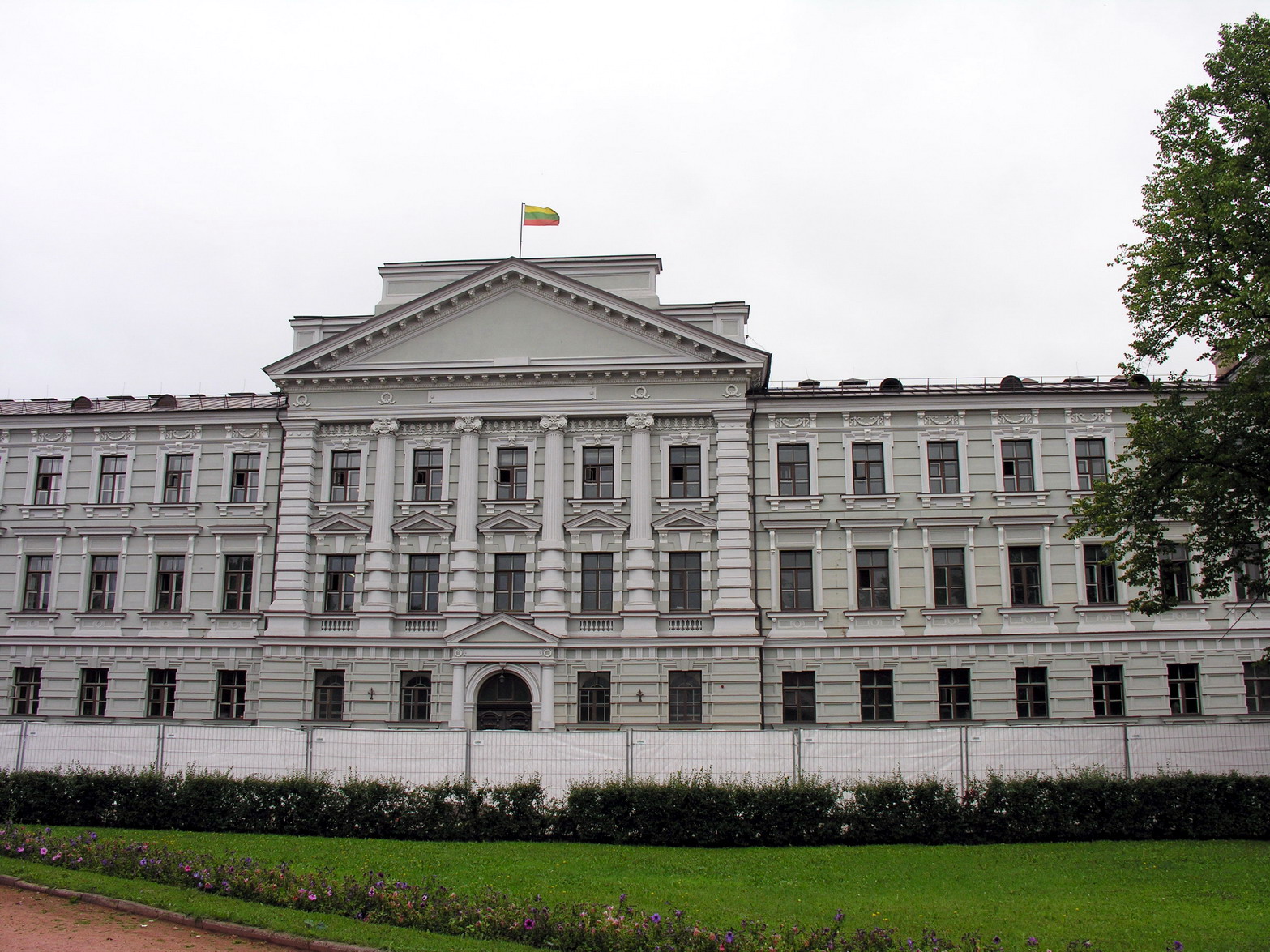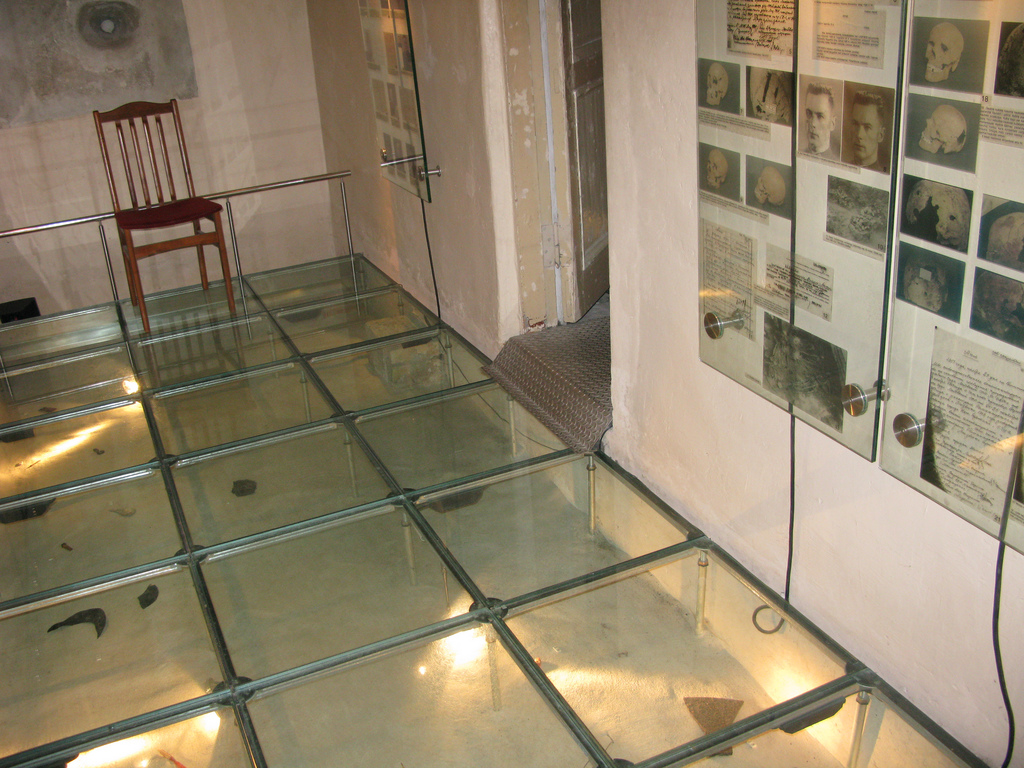Museum of Occupations and Freedom Fights on:
[Wikipedia]
[Google]
[Amazon]

 The Museum of Occupations and Freedom Fights ( lt, Okupacijų ir laisvės kovų muziejus) in
The Museum of Occupations and Freedom Fights ( lt, Okupacijų ir laisvės kovų muziejus) in
/ref> Although these events are considered a genocide only by a few historians, just a small part of the space is devoted to
 During the 19th century, Lithuania was part of the
During the 19th century, Lithuania was part of the
 The non-violent aspect of the resistance is represented by various books, underground publications, documents, and photographs. The collection pertaining to the
The non-violent aspect of the resistance is represented by various books, underground publications, documents, and photographs. The collection pertaining to the
Official website
Museum of Occupations and Freedom Fights at govilnius.lt
Official website - History of the building
Official website - The former execution camera
Official website - Collections
{{authority control 1992 establishments in Lithuania Decommunization History museums in Lithuania KGB Museums in Vilnius Museums of communism Museums established in 1992

 The Museum of Occupations and Freedom Fights ( lt, Okupacijų ir laisvės kovų muziejus) in
The Museum of Occupations and Freedom Fights ( lt, Okupacijų ir laisvės kovų muziejus) in Vilnius
Vilnius ( , ; see also other names) is the capital and largest city of Lithuania, with a population of 592,389 (according to the state register) or 625,107 (according to the municipality of Vilnius). The population of Vilnius's functional urba ...
, Lithuania
Lithuania (; lt, Lietuva ), officially the Republic of Lithuania ( lt, Lietuvos Respublika, links=no ), is a country in the Baltic region of Europe. It is one of three Baltic states and lies on the eastern shore of the Baltic Sea. Lithuania ...
, was established in 1992 by order of the Minister of Culture and Education and the president of the Lithuanian Union of Political Prisoners and Deportees
The Lithuanian Union of Political Prisoners and Deportees ( lt, Lietuvos politinių kalinių ir tremtinių sąjunga, LPKTS) was a political party in Lithuania between 1990 and 2004. It represented interest of those repressed by the Lithuanian SSR ...
. In 1997, it was transferred to the Genocide and Resistance Research Centre of Lithuania
The Genocide and Resistance Research Centre of Lithuania ( lt, Lietuvos gyventojų genocido ir rezistencijos tyrimo centras or ''LGGRTC'') is a state-funded research institute in Lithuania dedicated to "the study of genocide, crimes against hum ...
. The museum is located in the former KGB headquarters across from the Lukiškės Square
Lukiškės Square (other spellings include ''Łukiszki, Lukiski, Lukishki'', lt, Lukiškių aikštė) is the largest square (about in Vilnius, Lithuania, located in the center of the city. A major street in Vilnius, Gediminas Avenue, passes b ...
and is informally referred to as the KGB Museum.
The museum is dedicated mostly to collecting and exhibiting documents relating to the 50-year occupation of Lithuania by the Soviet Union
The Soviet Union,. officially the Union of Soviet Socialist Republics. (USSR),. was a transcontinental country that spanned much of Eurasia from 1922 to 1991. A flagship communist state, it was nominally a federal union of fifteen nationa ...
, the anti-Soviet Lithuanian partisans
The Lithuanian partisans () were partisans who waged a guerrilla warfare in Lithuania against the Soviet Union in 1944–1953. Similar anti-Soviet resistance groups, also known as Forest Brothers and cursed soldiers, fought against Soviet rule ...
, and the victims of the arrests, deportations
Deportation is the expulsion of a person or group of people from a place or country. The term ''expulsion'' is often used as a synonym for deportation, though expulsion is more often used in the context of international law, while deportation ...
, and executions that took place during this period. Before 2018, the museum was known as the Museum of Genocide Victims, reflecting a broadened definition of the ''genocide
Genocide is the intentional destruction of a people—usually defined as an ethnic, national, racial, or religious group—in whole or in part. Raphael Lemkin coined the term in 1944, combining the Greek word (, "race, people") with the ...
'' used by the Genocide and Resistance Research Centre.Slate: Double Genocide - Lithuania wants to erase its ugly history of Nazi collaboration—by accusing Jewish partisans who fought the Germans of war crimes./ref> Although these events are considered a genocide only by a few historians, just a small part of the space is devoted to
the Holocaust in Lithuania
The Holocaust in Lithuania resulted in the near total destruction of Lithuanian (Litvaks) and Polish Jews, living in '' Generalbezirk Litauen'' of '' Reichskommissariat Ostland'' within the Nazi-controlled Lithuanian SSR. Out of approximately 2 ...
, the event that is universally considered a genocide. In 2018, the museum was renamed the Museum of Occupations and Freedom Fights.
History of the building
 During the 19th century, Lithuania was part of the
During the 19th century, Lithuania was part of the Russian Empire
The Russian Empire was an empire and the final period of the Russian monarchy from 1721 to 1917, ruling across large parts of Eurasia. It succeeded the Tsardom of Russia following the Treaty of Nystad, which ended the Great Northern War ...
. The building, completed in 1890, originally housed the court of the Vilna Governorate
The Vilna Governorate (1795–1915; also known as Lithuania-Vilnius Governorate from 1801 until 1840; russian: Виленская губерния, ''Vilenskaya guberniya'', lt, Vilniaus gubernija, pl, gubernia wileńska) or Government of V ...
. The German Empire
The German Empire (),Herbert Tuttle wrote in September 1881 that the term "Reich" does not literally connote an empire as has been commonly assumed by English-speaking people. The term literally denotes an empire – particularly a hereditary ...
used it during its World War I
World War I (28 July 1914 11 November 1918), often abbreviated as WWI, was List of wars and anthropogenic disasters by death toll, one of the deadliest global conflicts in history. Belligerents included much of Europe, the Russian Empire, ...
occupation of the country. After independence was declared, it served as a conscription center for the newly formed Lithuanian army and as the Vilnius commander's headquarters. During the Lithuanian Wars of Independence
The Lithuanian Wars of Independence, also known as the Freedom Struggles ( lt, Laisvės kovos), refer to three wars Lithuania fought defending its independence at the end of World War I: with Bolshevik forces (December 1918 – August 1919), Be ...
, the city was briefly taken by the Bolshevik
The Bolsheviks (russian: Большевики́, from большинство́ ''bol'shinstvó'', 'majority'),; derived from ''bol'shinstvó'' (большинство́), "majority", literally meaning "one of the majority". also known in English ...
s, and the building housed commissariats and a revolutionary tribunal. Following Żeligowski's Mutiny
Żeligowski's Mutiny ( pl, bunt Żeligowskiego, also ''żeligiada'', lt, Želigovskio maištas) was a Polish false flag operation led by General Lucjan Żeligowski in October 1920, which resulted in the creation of the Republic of Central Lithuani ...
of 1920, Vilnius and its surroundings were incorporated into Poland, and the building housed the courts of justice for the Wilno Voivodship.
Lithuania was invaded by the Soviet Union in 1940, and following an ultimatum, became a Soviet Socialist Republic. Mass arrests and deportations followed, and the building's basement became a prison. In 1941 Nazi Germany
Nazi Germany (lit. "National Socialist State"), ' (lit. "Nazi State") for short; also ' (lit. "National Socialist Germany") (officially known as the German Reich from 1933 until 1943, and the Greater German Reich from 1943 to 1945) was ...
invaded the country; the building then housed the Gestapo
The (), abbreviated Gestapo (; ), was the official secret police of Nazi Germany and in German-occupied Europe.
The force was created by Hermann Göring in 1933 by combining the various political police agencies of Prussia into one orga ...
headquarters. Inscriptions on the cell walls from this era remain. The Soviets retook the country in 1944, and from then until independence was re-established in 1991, the building was used by the KGB, housing offices, a prison, and an interrogation center. Over 1,000 prisoners were executed in the basement between 1944 and the early 1960s, about one-third for resisting the occupation. Most bodies were buried in the Tuskulėnai Manor
Tuskulėnai Manor ( lt, Tuskulėnų dvaras) is a neoclassical manor in Žirmūnai elderate of Vilnius, Lithuania. It is best known as burial grounds of people executed by the KGB in 1944–1947. After Lithuania regained independence in 1990, th ...
, which underwent reconstruction and hosts a branch of the museum.
In addition to housing the museum, the building now serves as a courthouse and as the repository of the Lithuanian Special Archives Lithuanian Special Archives is an archive in Lithuania for the storage of documents from the period 1940–91. Numerous KGB and Lithuanian SSR Ministry of Interior documents were left in Lithuania after it gained independence from the Soviet Union ...
.
Collections
 The non-violent aspect of the resistance is represented by various books, underground publications, documents, and photographs. The collection pertaining to the
The non-violent aspect of the resistance is represented by various books, underground publications, documents, and photographs. The collection pertaining to the Forest Brothers
The Guerrilla war in the Baltic states was an armed struggle which was waged by the Latvian, Lithuanian, and Estonian partisans, called the Forest Brothers (also: the "Brothers of the Wood" and the "Forest Friars"; et, metsavennad, lv, mež ...
' armed resistance includes documents and photographs of the partisans. A section devoted to the victims of deportations, arrests, and executions holds photographs, documents, and personal belongings; this collection is continually expanded by donations from the public, seeing the museum as the best means of preserving the materials.
Controversy
No exposition devoted tothe Holocaust in Lithuania
The Holocaust in Lithuania resulted in the near total destruction of Lithuanian (Litvaks) and Polish Jews, living in '' Generalbezirk Litauen'' of '' Reichskommissariat Ostland'' within the Nazi-controlled Lithuanian SSR. Out of approximately 2 ...
existed in the Museum of Genocide Victims until 2011, despite the fact that more Jews were killed in Lithuania than in Germany, both in relative and absolute numbers, and that only a few historians believe Soviet repression against the Lithuanians constituted a genocide. To address international criticism, a small exposition describing the Holocaust in Lithuania was added in 2011. In April 2018, after a piece by Rod Nordland in ''The New York Times
''The New York Times'' (''the Times'', ''NYT'', or the Gray Lady) is a daily newspaper based in New York City with a worldwide readership reported in 2020 to comprise a declining 840,000 paid print subscribers, and a growing 6 million paid ...
'' quoted Dovid Katz
Dovid Katz (Yiddish: , also , Hirshe-Dovid Kats, , born 9 May 1956) is an American-born, Vilnius-based scholar, author and educator, specializing in Yiddish language and literature, Lithuanian Jewish culture, and the Holocaust in Eastern Europe. ...
as saying the museum was "a 21st-century version of Holocaust denial", the museum changed its name to the Museum of Occupations and Freedom Fights. As of 2020, the museum "focuses almost entirely on the murder of the Lithuanian non-Jewish population, while perpetrators of the Holocaust are lauded as victims in their countries’ struggle against Soviet occupation."
See also
* Double genocide theoryReferences
External links
Official website
Museum of Occupations and Freedom Fights at govilnius.lt
Official website - History of the building
Official website - The former execution camera
Official website - Collections
{{authority control 1992 establishments in Lithuania Decommunization History museums in Lithuania KGB Museums in Vilnius Museums of communism Museums established in 1992